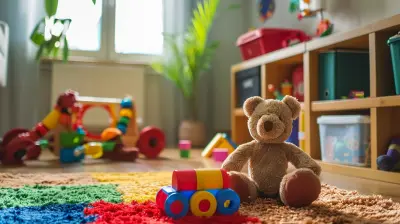Fostering Independence in Children with a Mindful Approach
16 September 2025
Let’s be honest. Raising independent kids in today’s world feels like walking a tightrope—one wrong move, and boom, you’re labeled either too controlling or too hands-off. Sound familiar? You’re not alone. Every parent wrestles with figuring out when to step in and when to step back. But here’s the kicker: it’s not about perfection. It’s about intention. And that’s where mindfulness comes in.
Mindfulness isn't just some trendy buzzword or a spiritual fad. It's a superpower. When used right, it can shape your parenting style into a grounded, empowering force that nurtures capable, resilient kids—without sacrificing connection. So, ready to ditch the helicopter blades and help your kids soar on their own?
Let’s break it down—real talk, no sugarcoating.
What Does It Really Mean to Foster Independence in Kids?
First off, independence isn’t about throwing your kid into the deep end and hoping they figure it out. It’s not about letting a six-year-old cook dinner (unless it's peanut butter toast). And it's definitely not about turning your back when they’re facing something tough.Fostering independence means teaching your child to trust themselves, make age-appropriate decisions, navigate challenges, and manage responsibilities—with YOU as their steady guide.
It’s not a hands-off approach. It’s a hand-in-hand approach with intentional looseness. Like teaching them to ride a bike—you hold the seat while they wobble, but you eventually let go.
The Magic of Mindfulness in Parenting
Now, hold up. What does mindfulness have to do with raising independent kids?Everything.
Mindful parenting means being present, thoughtful, and non-reactive. Think of it as parenting with your eyes wide open—even when they roll them at you.
When you parent mindfully, you pause before jumping in. You let your kid struggle a bit instead of rescuing. You listen more than you talk. And you realize that their mistakes are not a reflection of your worth as a parent. (Yeah, that one stings a bit.)
Why Mindfulness Matters:
- Slows down reactive parenting- Builds emotional intelligence
- Creates a calm, secure environment where kids feel safe to try
- Encourages problem-solving and self-regulation
Simply put, mindfulness is the secret sauce. It calms the chaos, inside and out.
How to Foster Independence in Kids (Without Losing Your Mind)
Alright, time to get practical. Let’s talk strategy. Because theory is cute and all, but you need stuff that actually works before the toddler paints the wall with yogurt again.1. Start Small, But Start Early
You don’t wait until your teenager is failing algebra to teach responsibility. Independence begins in the little years—with tiny moments that build big confidence.Let your toddler pick out their clothes (even if it’s mismatched). Let your 5-year-old pour their juice. Yes, they’ll spill. But that’s how they learn.
Quick Tip: Ask yourself, “What can my child do on their own—imperfectly?”
2. Less Fixing, More Coaching
We all want to swoop in and make things better. But fixing everything robs kids of the golden opportunity to problem-solve. Instead, channel your inner coach.Instead of, “Here, let me do that,” try, “What’s your plan to fix it?”
Your role? Guide. Ask thoughtful questions. Let them wrestle with it.
It’s like giving them the pen instead of writing the story for them.
3. Create Routine and Responsibility
Routine is the training ground for independence. Chores, schedules, morning checklists—they all provide structure with freedom baked in.No, chores are not child abuse. They’re life skills training.
When a child knows what’s expected, they can take ownership. And when they take ownership, boom—independence is growing.
4. Let Them Fail—Safely
This one stings. But failure is not the enemy. It’s the blueprint for growth.Let your child forget their homework once. Watch them navigate the consequences. Let them build the LEGO set upside down.
Be there for the aftermath—not to say "I told you so," but to help them reflect and bounce back.
Mindful parenting says: “I trust you enough to let you struggle.”
5. Model Mindful Independence
Kids watch us like hawks. Want them to be capable, resilient, patient? You’ve gotta walk the walk.Let them see you mess up and recover. Let them hear you say, “I need a break” when you’re fried. Let them watch you take responsibility for your choices.
Your behavior is their blueprint. Period.
Mindful Habits to Practice Every Day
Want to really embed independence and mindfulness into your parenting DNA? Make it a daily practice. It doesn’t have to be complicated.Here’s a short but mighty list:
- Pause before reacting – Take one breath before responding to your child’s whining.
- Validate their emotions – “I see that you’re frustrated” goes a long way.
- Encourage effort over outcome – “You worked hard on that,” instead of “Good job.”
- Let silence sit – Don’t rush to fill the space; let them process.
- Ask open-ended questions – “What do you think?” instead of telling them what to do.
These small shifts have big impact.
Age-by-Age Guide to Building Independence
Every stage is different. What works for a 4-year-old is chaos for a 14-year-old. So here’s a rough guide—take it with flexibility, not as a strict formula.Toddlers (Ages 2–4)
- Let them choose between two options- Encourage self-feeding, dressing, and toileting
- Use simple routines and visuals
Mindful Mantra: “Mistakes are part of learning.”
Early Childhood (Ages 5–7)
- Assign simple chores like setting the table- Ask for their help with daily tasks
- Encourage decision-making
Mindful Mantra: “I believe in your ability to try.”
Tweens (Ages 8–12)
- Give them responsibilities like packing lunch or managing homework- Let them make small purchases with their allowance
- Start conversations about values and consequences
Mindful Mantra: “Your choices belong to you.”
Teens (Ages 13–18)
- Encourage time management skills and planning- Allow them to solve peer issues (with support if needed)
- Teach financial and emotional independence
Mindful Mantra: “I’m here if you need me, but I won’t rescue you.”
How to Handle the Pushback (Because It’s Coming)
Let’s not pretend this journey is conflict-free. Kids will roll their eyes, resist, complain, and possibly mutiny.That’s normal. That means they’re growing.
Here’s how to stay sane:
- Stay consistent – Don’t back down just because they whine.
- Stay calm – Reacting with anger just escalates the power struggle.
- Pick your battles – Don’t die on every hill. Dirty socks in the hallway? Meh.
- Celebrate wins – Acknowledge their growth, even if it’s just brushing their teeth without a meltdown.
Remember, conflict can be connection—if you approach it mindfully.
Final Thoughts: Let Go, But Stay Close
Here’s the real talk ending you didn’t ask for but need.You are not raising a child to need you forever. Your job is to raise them to be okay without you—and that’s both beautiful and brutal.
Mindfulness keeps you grounded during the emotional tug-of-war. It reminds you that stepping back doesn’t mean stepping away. It means standing beside them—not in front.
It takes guts. It takes patience. It takes a whole lotta deep breaths.
But if you stay the course and keep showing up mindfully, you’ll raise a human who can stand tall, fall down, and rise stronger—with you cheering in the background.
And that, my friend, is the ultimate parenting win.
all images in this post were generated using AI tools
Category:
Mindful ParentingAuthor:

Max Shaffer
Discussion
rate this article
1 comments
Capri Kane
Empowering children to be independent through mindfulness cultivates resilience and self-awareness. By encouraging reflective practices, parents can help their kids navigate challenges confidently, fostering not just autonomy but also a deep understanding of their emotions and choices in everyday life.
September 19, 2025 at 2:47 PM

Max Shaffer
Thank you for your insightful comment! I completely agree that mindfulness helps children build resilience and self-awareness, empowering them to face challenges with confidence.


